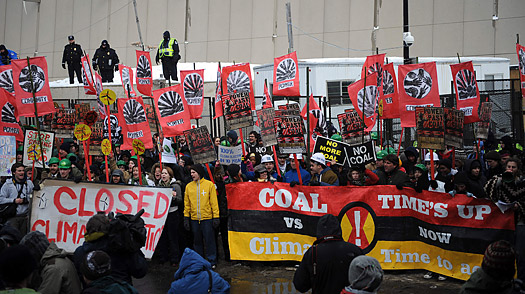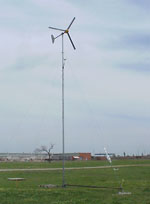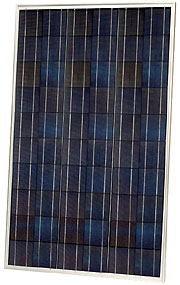really really really big home. Maybe a neighborhood or a subdivision. Still:
http://northernpower.com
Catch the Wind
…by discovering the Northwind 100! Northern Power’s 35 years as a wind industry leader has informed the intelligent, elegant and powerful design of our 100kW turbine.
Discover how the gearless direct drive technology, aerodynamically designed blades and SmartView Web Service create the ideal energy solution for your application.
Call us at 1 877 90 NORTH. We look forward to working with you to provide solutions for your energy needs.
What’s New?
New York Times article highlights the benefits of Northern Power’s turbines
Click Here
Northern Power’s team is expanding with many great opportunities
View Our Job Listings Here
:}
100 Kw is a tad big for our little 850 sq. ft. house but please note THEY Are Hiring. These are the much bandied about “green jobs”. Who else is hiring? MacDonalds? Back to the more affordable turbines:
http://www.redriven.net/
No. 1 in Modern Energy
Over the past year, the term “going green” has conquered the world. The media and environmental organizations are promoting sustainability, persuading people to live ecologically conscious lifestyles for the sake of the environment and longevity of the planet. A green lifestyle is no longer just a necessity, but also a huge trend. People everywhere are challenging themselves to reduce their ecological footprint by recycling, shopping with reusable bags, reducing their hot water usage, and purchasing clothing made from environmentally friendly materials. [ Read More … ]
Almost everyone is doing something small to contribute to the sustainability of the environment. ReDriven wants everyone to take their passion for the environment a step further by considering a wind turbine. Very few people reflect on the environmental impact of their energy source. They may know that it their power source is bad for the environment but think of it as a necessity; everyone needs electricity. A wind turbine substantially reduces and almost eliminates the pollution and C02 emissions generated from a traditional power source, making them a great resource for people and communities looking to significantly reduce their environmental footprint. With a wind turbine, people are able to benefit from the convenience of electricity without substantially harming the planet.
This year, the United States Government passed the U.S. Renewable Energy Tax Incentive Extension, granting tax credits to people and businesses that purchase a wind turbine. The government believes that by allowing people easier access to diverse energy sources, including a wind turbine, energy prices will drop and businesses will be able to make an easy transition into more environmentally friendly production. Like many others, the government is recognizing the ecologically beneficial nature of the wind turbine, viewing them as an intricate and essential component of America’s future. By giving people and businesses tax credits for purchasing a wind turbine, they are encouraging them to live sustainably and creating more environmentally friendly jobs, thereby promoting a healthier and more ecologically friendly America.
Few people realize how damaging their traditional fossil fuel energy sources are for the environment. With the majority of citizens still using fossil fuels and not investing in a wind turbine, dangerous amounts of carbon dioxide, carbon monoxide, nitrogen oxides, sulfur oxides, particulates, and mercury are released into the environment on a daily basis. The use of fossil fuels over a wind turbine not only hinders people’s well-being and health, but also contributes to green house gasses and global warming. It is imperative that all families and businesses consider the long term environmental advantages of the wind turbine. Unlike traditional fossil fuel sources, a wind turbine does not emit pollution while generating energy. Although, pollution is generated while manufacturing a wind turbine, once it is constructed it is emission and pollution free. After nine months of environmentally friendly use, a wind turbine easily pays back the pollution emitted during manufacturing. Additionally, a substantial percentage of a wind turbine is fully recyclable. A wind turbine is an ideal energy source for anyone looking for an environmentally friendly and sustainable electricity source.
It is clear that the environment is in a dire situation. People everywhere are clamoring to do their part in saving the planet but sometimes a carrying reusable grocery bags and recycling just isn’t enough. ReDriven wants everyone to consider replacing their energy source with a wind turbine. Taking energy from the natural environment, a wind turbine preserves the ecological system by eliminating pollution released during electricity production. A wind turbine is the future of energy generation and an excellent way for people to significantly reduce their ecological footprint.
Wind Power
Throughout the world, wind power is quickly gaining popularity. Even though wind power only accounts for 1% of the earth’s power, the number is continually rising as wind power gains ground as a profitable and effective energy source. Wind power electricity production has quadrupled over the past six years, with Denmark, Germany, the United States, and Spain, leading the pack. Denmark generates one fifth of its total electricity through wind power, which is the highest production rate in the world. The United States and European governments, businesses, and people are championing wind power, recognizing its affordability and beneficial effects on the environment. [ Read More … ]
Many countries are now investing in wind power over fossil fuels, causing the industry to grow substantially from year to year. ReDriven wants to supply people with the tools and knowledge they need to generate ecologically friendly electricity. Wind power does not produce air pollution while generating electricity, making it better for the environment than fossil fuels, which contribute to greenhouse gas emissions and global warming. With 20 KW, 10 KW, and 5 KW units, ReDriven have wind power turbines to fulfill all businesses, companies, and governments needs. Their modern and aesthetically pleasing wind power generators are an excellent and modern source of electricity for people looking for a cost effective and environmentally friendly energy source. People throughout the world are advocating for wind turbines and their positive effects on the environment. ReDriven is devoted to helping people purchase and attain wind power electricity sources.
In 1999, wind power only accounted for .1% of the United States’ total generated electricity. Over the past nine years, attitudes towards the environment have changed, causing wind power electricity to rapidly increase; wind power is now over 1% of the countries total electricity. With the rise of green living and the popularity of the “Planet Earth” documentary, people are no longer blindly polluting and countries and families alike are looking for more sustainable energy sources. The environment has become an internationally relevant topic that everyone is aware of. The government and environmentally conscious businesses and home owners are taking it upon themselves to consider more viable energy sources that are less harmful to the environment than traditional fossil fuels. Fortunately, they have found it in wind power; The U.S. Department of Energy has discovered that the abundance of wind flowing across the Great Plains has the ability to power the entire nation. That combined with the wind power produced by offshore turbines in the Great Lakes area guarantees an effective and sustainable means of providing the country with electricity. As time goes on, the environment will become an increasingly important political and social issue, causing the number of wind power turbines in the states to grow. This highly economic and environmentally friendly energy source will soon dominate the industry.
ReDriven realizes that wind power is the future of electricity. They are the leading American developer of wind turbines and offer 20 KW, 10 KW, and 5KW unit wind power turbines and a variety of tower options. All packages include generators, blades, flanges, grid controllers, inverters, and isolation transformers of differing sizes and powers, depending on the package ordered. Additionally, the height of the wind power turbine tower ranges from regular to hydraulic towers from 12 to 36 m tall. These modern and sleek wind power turbines are guaranteed to suit any natural landscape and produce efficient and environmentally friendly electricity. People concerned with the effectiveness and price of wind power turbines can log on to the ReDriven website to calculate the amount of energy that will be produced from the unit chosen. By filling out a form that takes into consideration average energy costs and consumption, wind speed, and other variables, everyone is able to see the potential effectiveness of their wind power turbine. ReDriven is an excellent resource for people looking to purchase and gain information on wind power.
Countries and people everywhere are searching for more sustainable energy sources and looking towards wind power turbines. With people becoming more environmentally conscious, wind power will become the electricity source of the future. ReDriven offers a variety of wind turbines to fulfill all corporations, governments, and personal needs. By logging on to their website, everyone is able to find out how wind power can work for them.
Wind Generator
Few people ever consider investing in an alternative energy source because they believe that new electricity generators are ineffective. Unfortunately, wind generators are still controversial and have a variety of insubstantial issues surrounding them. The reality is that a wind generator is an incredibly effective and environmentally friendly means to produce electricity and the majority of concerns surrounding them are incorrect and misleading. [ Read More … ]
2 KW Wind Turbine

The ReDriven 2 kw wind turbine system is an excellent system for on-grid applications where 250 kwh -500 wkh of power per month will provide the necessary capacity to offset partially or fully the utility bill for your seasonal property or home.
[ Read More … ]
The ReDriven 2kw is a tailed unit that uses the wind direction to help it determine where best to capture the wind. This turbine head weighs approximately 116 lbs (53 kg) and comes with the ReDriven controller, a Power One Inverter, blades.
Product Features:
- Start up wind speed is 4.4 mph
- Rated wind speed (generate 2 KW) is 20.1 mph
- Maximum power 2000 watts
- 3 blades measuring 3.2 meters in diameter
- Recommended tower height is 9 meters
5 KW Wind Turbine

The ReDriven 5 kw wind turbine system is the first in our line of non-tailed units. The technology found in the 5 kw ReDriven Controller is identical to the larger 10 kw and 20 kw units. Therefore you receive all the advantages of a larger unit packed into this ultra efficient power house.
[ Read More … ]
:}
These folks even put a windmill on the lawn of the Federal Capitol Building. Way to go people:
http://www.windenergy.com
Bringing low-cost, reliable wind energy to the world

U.S. Federal government endorses small wind turbines with tax credit
New law gives up to $4,000 to consumers who purchase Southwest Windpower’s Skystream 3.7
Flagstaff, Ariz. — Southwest Windpower, the leading manufacturer of small wind turbines, played a leadership role in the passage of new legislation creating a federal-level tax credit for qualified small wind turbines.
Press Release | FAQs | Tax Form
:}
We will finish the list up tomorrow.
:}
 SPRINGFIELD – Alexander “Alex” Joseph Casella, 69, died Thursday, March 5, 2009, at his home in Springfield.Alex was born August 10, 1939, in Taylor, PA, the son of Alexander Joseph Casella Sr. and Josephine M. Cesare Casella. He married Thanawan Kohrianchai on July 1, 2001, in Springfield, Illinois.Alex grew up in Moosic, PA. He received a B.S. in Physics from Villanova University, an M.A. in Physics from Drexel University, and a Ph.D. in Physics from Pennsylvania State University. He began his professional career in 1961 as a Physicist for the U.S. Dept. of Defense at the Frankford Arsenal in Philadelphia. In 1969, he became a professor of Physics at Jacksonville University in Florida. Alex embarked on a 30 year career in 1973 with Sangamon State University/UIS as Professor of Environmental Studies and Physics. He became the Director of Energy Studies at SSU in 1975. From 1989-1996, Alex served as Dean of the School of Public Affairs and Administration. In 2002, he became Professor Emeritus, Environmental Studies and Physics.Alex was the producer and host of about fifty, half-hour interview shows on environment/energy issues starting in 1985. He also hosted two weekly interview shows, “Faculty Focus” and “Peace Talks.”Alex was a member of Sigma Pi Sigma, Illinois Environmental Council, American Assoc. for the Advancement of Science, Union of Concerned Scientists (IL Coordinator), Sierra Club, Charter Member of Better World Society and Worldwatch Institute. He served on numerous boards and committees, including Energy Consultants Associates, Earth Week 1990, Springfield Urban League, and Springfield Area Arts Council. He provided numerous testimonies to committees of the State of IL House and Senate in areas of Energy Policy and was the prolific author of articles, papers, lectures, and letters to the editor on numerous and sundry topics.A loyal supporter of the Democratic Party, Alex ran for Alderman of Ward 7 in 1999, victory narrowly eluding him by a mere 8%.
SPRINGFIELD – Alexander “Alex” Joseph Casella, 69, died Thursday, March 5, 2009, at his home in Springfield.Alex was born August 10, 1939, in Taylor, PA, the son of Alexander Joseph Casella Sr. and Josephine M. Cesare Casella. He married Thanawan Kohrianchai on July 1, 2001, in Springfield, Illinois.Alex grew up in Moosic, PA. He received a B.S. in Physics from Villanova University, an M.A. in Physics from Drexel University, and a Ph.D. in Physics from Pennsylvania State University. He began his professional career in 1961 as a Physicist for the U.S. Dept. of Defense at the Frankford Arsenal in Philadelphia. In 1969, he became a professor of Physics at Jacksonville University in Florida. Alex embarked on a 30 year career in 1973 with Sangamon State University/UIS as Professor of Environmental Studies and Physics. He became the Director of Energy Studies at SSU in 1975. From 1989-1996, Alex served as Dean of the School of Public Affairs and Administration. In 2002, he became Professor Emeritus, Environmental Studies and Physics.Alex was the producer and host of about fifty, half-hour interview shows on environment/energy issues starting in 1985. He also hosted two weekly interview shows, “Faculty Focus” and “Peace Talks.”Alex was a member of Sigma Pi Sigma, Illinois Environmental Council, American Assoc. for the Advancement of Science, Union of Concerned Scientists (IL Coordinator), Sierra Club, Charter Member of Better World Society and Worldwatch Institute. He served on numerous boards and committees, including Energy Consultants Associates, Earth Week 1990, Springfield Urban League, and Springfield Area Arts Council. He provided numerous testimonies to committees of the State of IL House and Senate in areas of Energy Policy and was the prolific author of articles, papers, lectures, and letters to the editor on numerous and sundry topics.A loyal supporter of the Democratic Party, Alex ran for Alderman of Ward 7 in 1999, victory narrowly eluding him by a mere 8%.















